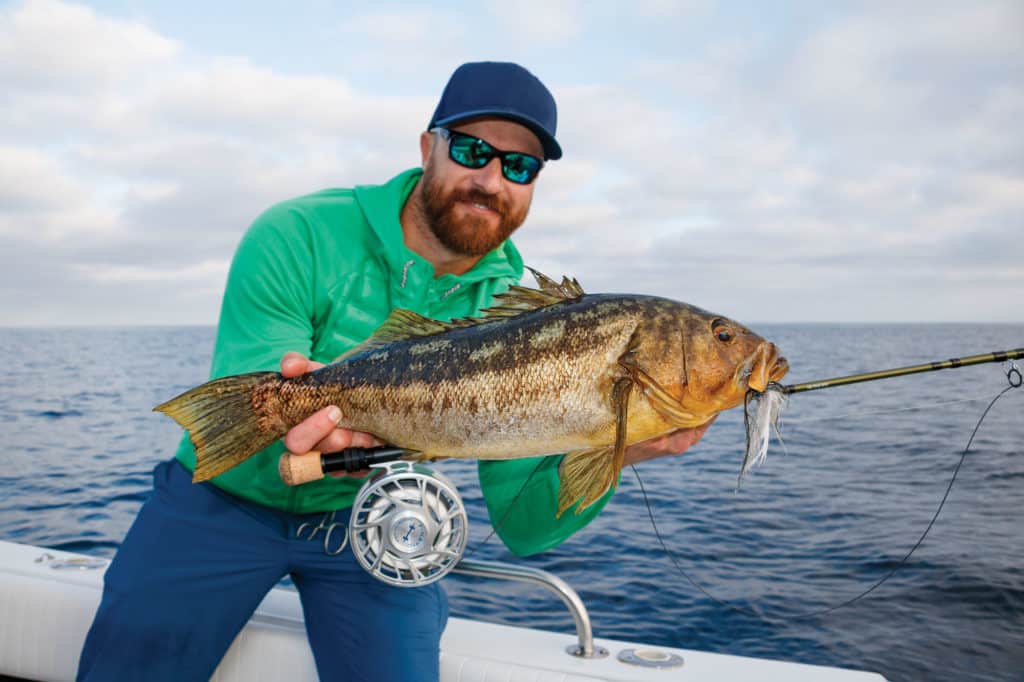
Brent Brauner had dreamed for years of fly fishing the island of Santa Catalina, off the coast of Southern California. On this day in early October, he got his chance, having joined me aboard my 21 1⁄2-foot center-console for the 24-mile crossing from the mainland.
I anchored near a reef, a few hundred yards off the mountainous front side of the island, where a current ran to the east, bending fronds of kelp below the surface. Brauner’s first cast put the fly about 75 feet astern. He let his sinking line descend for a few seconds, and then began to strip. He didn’t get far. A big kelp bass inhaled the streamer. Brauner set the hook, and line whizzed off the deck and through the rod guides as the bass bored deep.
The fish, now into the backing and using the current in its favor, bent the 10-weight fly rod nearly double. Brauner responded with heavy pressure, and the fish gave way a few inches at a time. A moment later, I slipped the net under a beautiful, brassy and chunky kelp bass—known locally as calico bass. We took a few photos and released it quickly to ensure its survival.
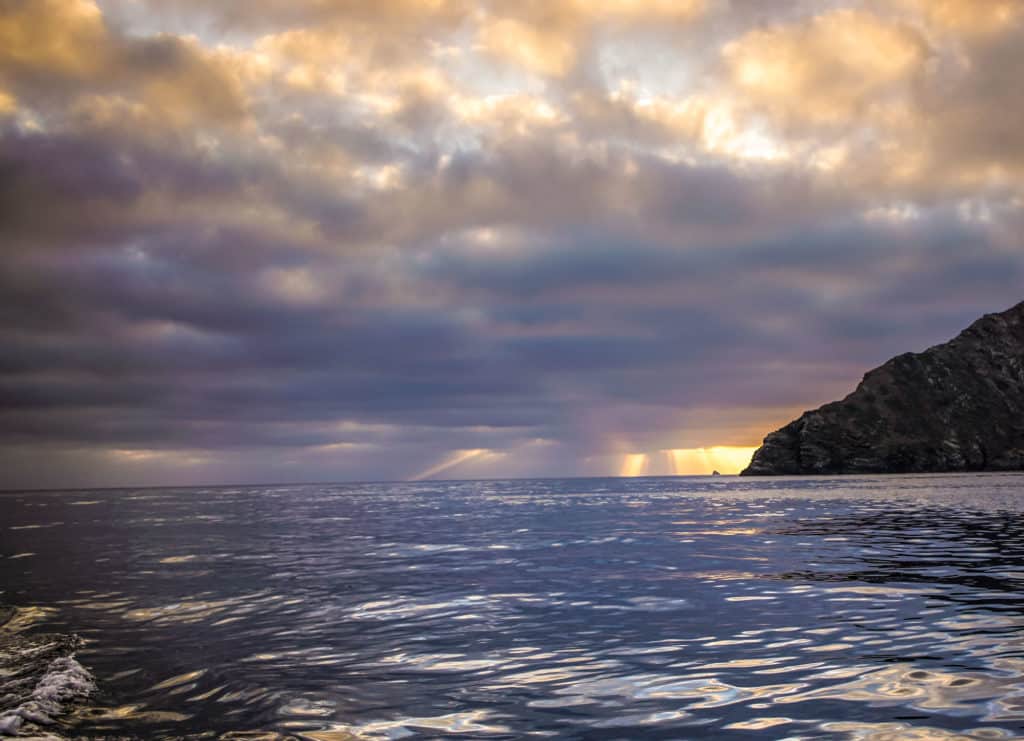
Popular Trend
Fly fishing Catalina Island has grown significantly in popularity during the past few years, says Capt. Vaughn Podmore of Saltyfly Charters, who has been fly-fishing off Southern California for 20 years.
“Clear water, magnificent scenery, and a variety of powerful fish make Catalina one of the hottest fly-fishing destinations on the West Coast,” says Podmore, who guides more than 260 days a year. The most common fly targets at Catalina include Pacific barracuda, Pacific bonito and kelp bass, all of which can reach 10 pounds or more. But the biggest prize for fly anglers is the California yellowtail, a species of amberjack that reaches weights in excess of 30 pounds.
This holy grail is tough to entice, but even tougher once hooked, known for sustained runs, and retreating to dense kelp beds and jagged reefs. Fly anglers are lucky to land 50 percent of the yellowtails they hook.
In the Zone
Structure, such as rocky shores, ledges, reefs and kelp beds, provides the most consistent hunting grounds. “I really like rocky points and reefs in 60 to 90 feet of water,” says Glenn Ueda, who has fished Catalina all of his life, but switched almost exclusively to fly-fishing about 13 years ago.
“I apply the lessons I learned as a gear angler to fly-fishing at Catalina,” Ueda explains. “Most of the same factors apply, and that includes keying on structure.”
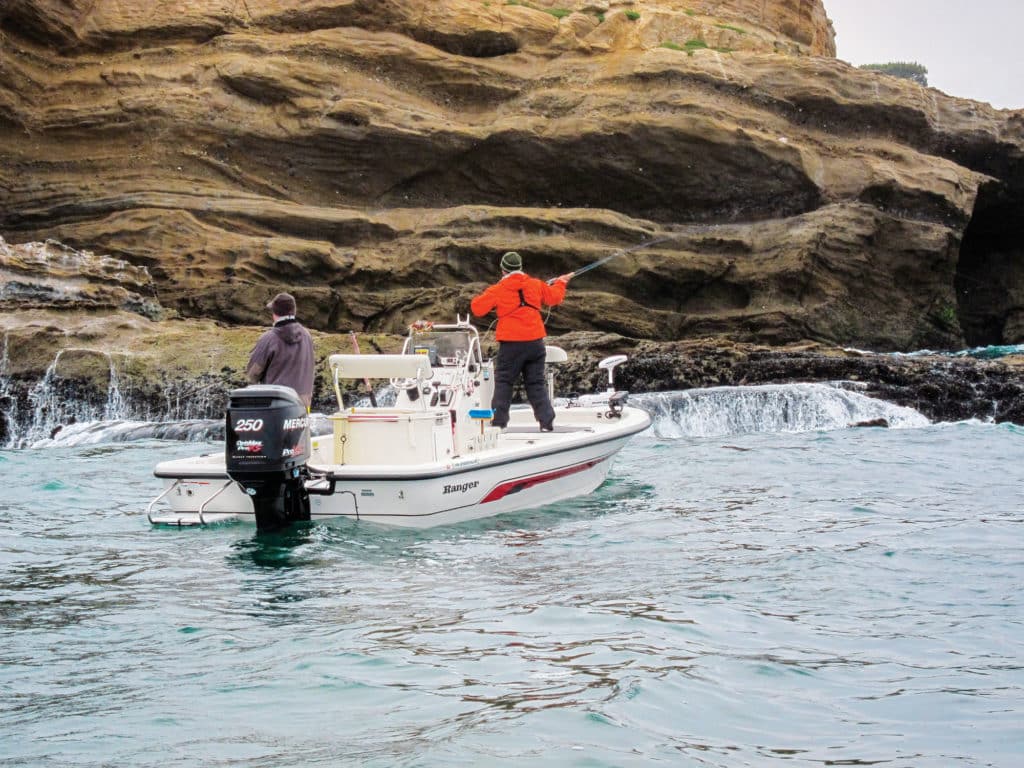
But there are differences. Fly-fishing scarcely lends itself to party boats with dozens of anglers on board, so it’s a game for small-boat charters and private boats.
Most fly-casters focus on the front (northerly) side of the island, in the lee of the wind and bumpy seas that complicate casting and presentation, often common conditions on the back of the island.
Current Affairs
Current is a critical factor when fishing Catalina Island. “You need the current flowing for good fishing, no matter what the species,” Podmore says. “When the current goes slack, so does the fishing.”
As current washes over and around deep reefs and kelp beds, fish feed higher in the water column, simplifying fly presentation. Current offers yet a third advantage to fly fishermen. “With the current running,” Podmore says, “you can roll out a 30-foot cast, and then strip your line into the water to let the current pull it out.”
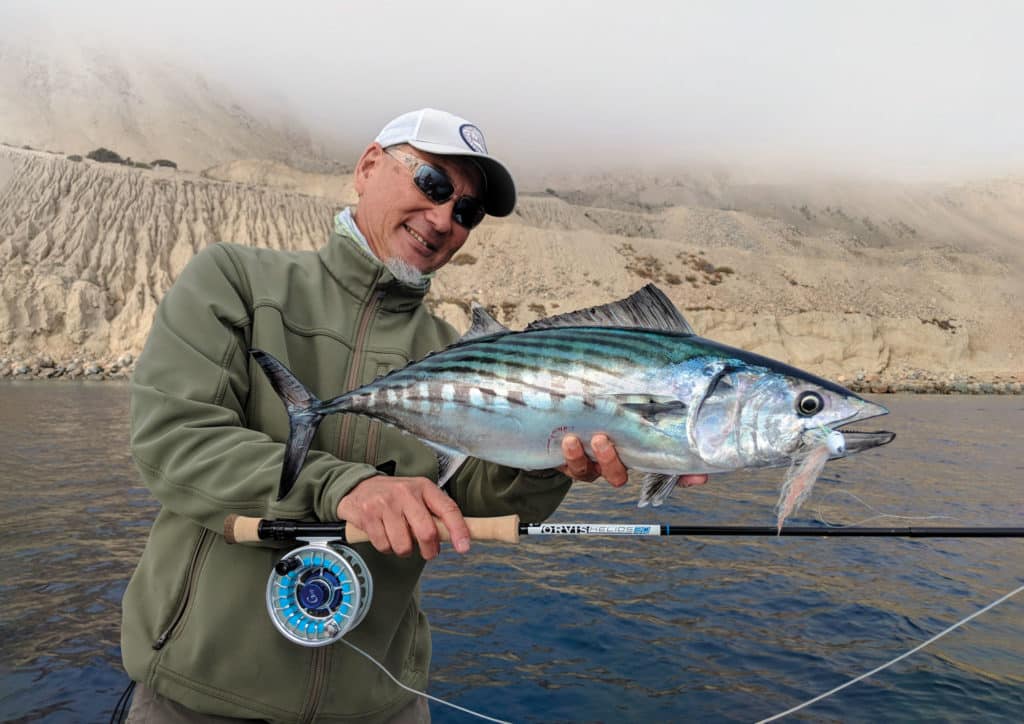
Ueda prefers a mild current that lets his 10-weight line sink 30 to 40 feet. “Ideally, you want a 45- degree retrieve angle,” he says. With the rod under his arm, Ueda strips line hand-over-hand to move the fly with a fast, darting action, which is key to catching bass, bonito and yellowtail.
“It’s like working a yo-yo iron,” Ueda says, referencing a popular technique with metal jigs for yellowtail. “You can’t strip the fly too fast.”
Boat Positioning
Positioning the boat properly plays a pivotal role, Podmore says. “You want the boat anchored up-current from the reef or kelp bed. This enables you to fish your fly over or up-current of the structure.”
A growing number of anglers are turning to GPS-guided trolling motors with virtual anchoring to position the boat, Ueda says. “It’s quick and easy to position the boat and, unlike a conventional anchor, you can effectively fish a spot when wind opposes the current.”
Chum It Up
Chumming the fish into a feeding mood is integral. Most anglers use a combination of chunks and live chum. A steady stream of sardine or mackerel chunks attracts schools of bait such as anchovies and topsmelt. Once bait gathers behind the boat, game species are more likely to attack a fly that looks like the forage species.
Fly anglers also carry live chum purchased from bait vendors such as Long Beach Bait Co. in Long Beach Harbor, or San Pedro Bait Co. near Cabrillo Beach. “Small anchovies, about 4 inches long, are the best live chum,” Ueda says. “You can carry a lot of them in the livewell, and fish don’t get full from eating them.”
Sardines also work, but they are usually larger. “We can’t carry as many live sardines, so we wait until we spot bass or yellowtail boiling in the chunk line before we put them out,” he says.
Match the Hatch
Streamer patterns that match small to medium baitfish prove effective at Catalina. Ueda’s go-to is a 4- to 5-inch fly that mimics an anchovy, one of the primary forage species in Southern California. However, he’s always prepared with additional fly patterns resembling topsmelt and pelagic red crabs.
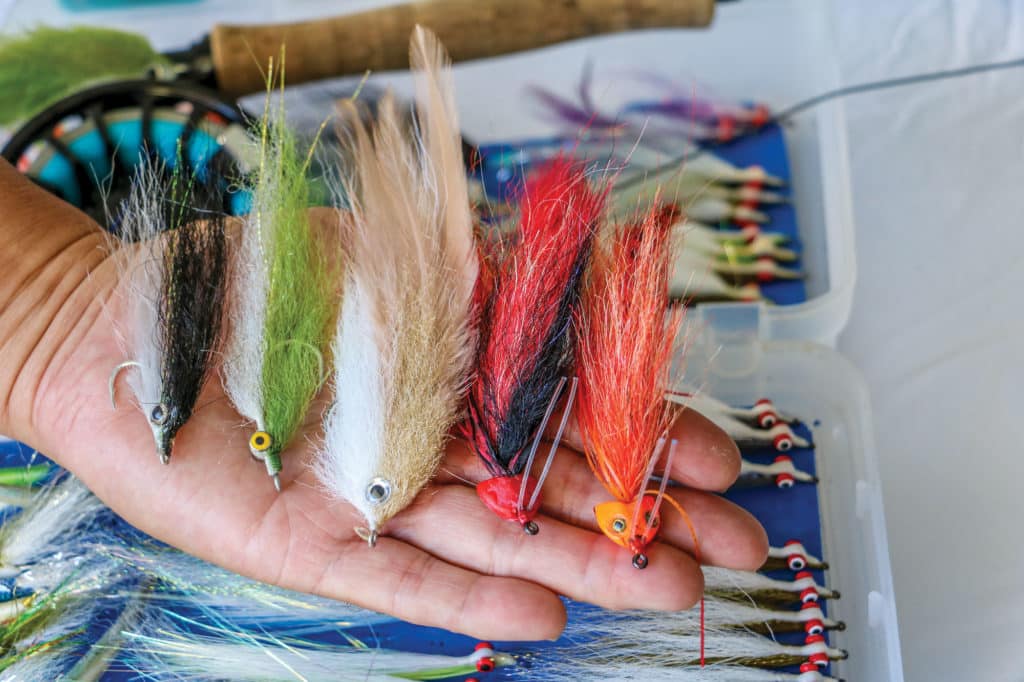
One of Podmore’s favorites is a 5- to 6-inch yak-hair sardine with a white belly, root-beer body, and an olive topside with a hint of black flash. “But don’t add too much flash because it will often put off the yellowtail,” he says.
A critical aspect to these patterns is stability during the retrieve. “They need to track straight without wobbling or yellowtail won’t eat them,” Podmore explains. Heavy, wide-gap hooks help stabilize the fly, but Podmore sometimes adds four loose wraps of lead wire on the bend of the hook to add some extra stability to the fly.
Battle Plan
Landing a big California yellowtail on fly tackle is not easy, but you can stack the odds in your favor with a 6- to 8-foot tippet of 25- to 30-pound-test fluorocarbon, Ueda says. He sets the drag on his reel at around 2 pounds, and also uses the short-pump fighting technique he learned as a gear angler for defeating big yellows, keeping the rod low while making short, quick pumps, and gaining line one turn of the handle at a time.
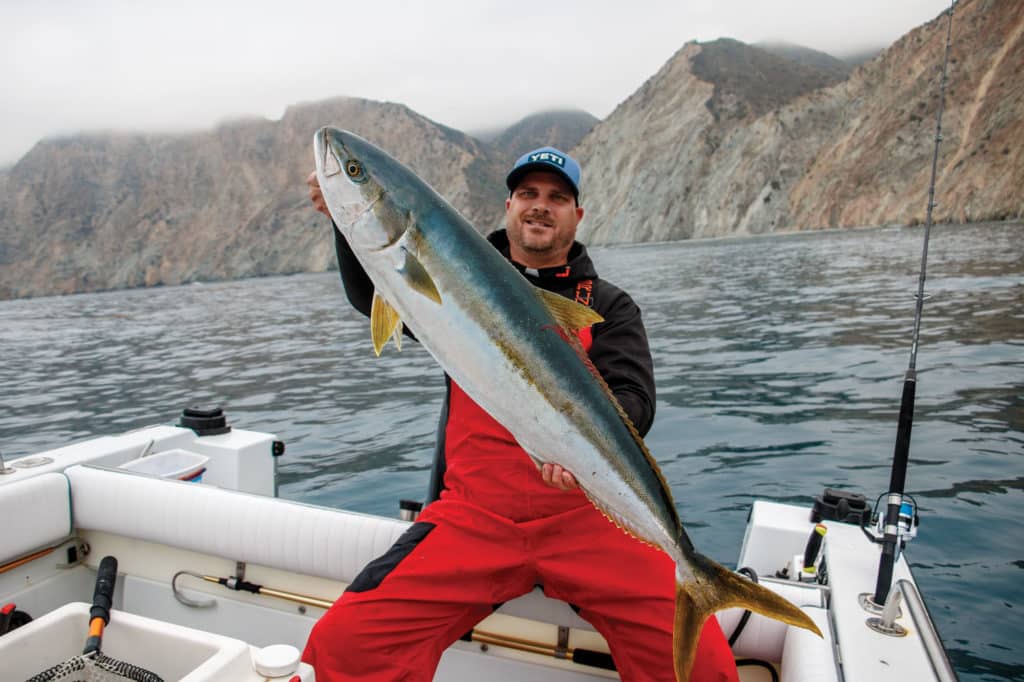
Ultimately, Santa Catalina Island has a way of captivating fly anglers, calling them to return and challenge the fish that inhabit its clear waters, swaying kelp beds and rocky reefs.
“With the wide variety of willing, hard-fighting species, Catalina Island is a fly-fishing dream,” Brauner says. “I can hardly wait for my next trip.”
Tackle Box
Rods: 9-foot, 8- to 10-weight, such as the Orvis Helios 3, Sage X, 1090-4 or equivalent
Reels: Saltwater class with reliable drag, such as the Galvan Torque or Hatch Finatic
Line: 8- to 10-weight progressive sinker, such as the Scientific Anglers Sonar Titan S3/S5/S7 or equivalent; 6 to 8 feet of 25- to 30-pound-test fluoro leader; 65-pound-test braid backing
Flies: 4- to 6-inch streamers to mimic anchovies, topsmelt and sardines; pelagic red crab patterns, attached with a loop knot
Planner
What: Kelp bass, Pacific barracuda, Pacific bonito, California yellowtail
When: April to November
Where: Santa Catalina Island structure, such as points, ledges, reefs and kelp beds
Who: Anglers with reliable craft from 20 feet up to make the run from the mainland. The following guides can take you to the island to fly-fish:
Saltyfly Charters
Capt. Vaughn Podmore
714-235-7715, saltyflyfishing.com
All Harbors Charter
Capt. Gerry Maheiu
949-279-6013, catchmorebass.com
Fishing with Decker
Capt. Jimmy Decker
949-280-4597, facebook.com/fishingwithdecker









